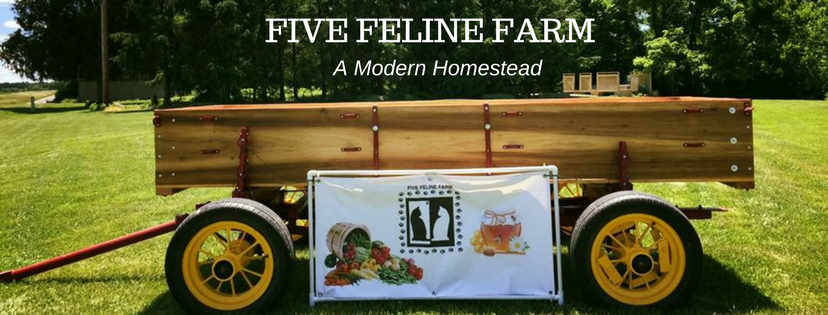Have you ever had a happy accident? You know the kind…you forget part of something, like an ingredient in a recipe, but it turns out great anyway?
That happened to us with one of our signature products: Hint-O-Mint Beek Balm. It is an odd name for a lip balm, but that is a story in itself.
When we first started Five Feline Farm, we had two main ideas. Sell our excess produce and raise honeybees. The honeybees were for both pollination and honey production. During our first honey harvest, we discovered a great byproduct: beeswax.
All-natural beeswax is a small farm entrepreneur’s dream. When you have a micro-operation, you need to squeeze maximum benefits from minimum input. Beeswax fits that description.
To harvest honey from the hive, each frame is “uncapped.” This is simply cutting off the top layer of wax to expose the honey. Frames are spun in a centrifuge to extract the honey. The wax cappings are collected in a tub.
There are a few steps to prepare the wax for use. Drain out the remaining honey drips, melt, and strain give us a pure wax ready to use.
The first wax-based product we attempted was a lip balm. It didn’t take long to branch into skin balms, but those are a topic for another post.
The first step to creating our lip balm was to figure out the ingredients. We picked up a tube of a famous national brand (you know, the one that everyone uses the brand name to refer to all lip balms)—no ingredients on the label.
Odd, we thought.
Off to the internet for a search. After digging through many pages on the brand website, we understood why the label does not include the ingredients. There are too many to fit on a lip balm tube! Then very few ingredients in the list had easily pronounceable names. It sounded like an experiment in a top-secret science lab.
Plus, the first ingredient is petroleum.
Petroleum comes from crude oil. For those living near an oil field, you are familiar with the odor. It smells, well, chemical and a bit gross. If you have never been near an oil field, imagine a thick sludge that smells like a blend of petroleum jelly, used motor oil, and gasoline. All I could imagine was smearing that voluntarily on my lips.
Nope.
Time for a different formula. An all-natural formula. One whose ingredients would fit on a tiny balm tube label.
Eureka!, as they say.
We had an abundance of beeswax. All we needed was sweet almond oil, vitamin E oil, and a food-safe flavoring. We source sweet almond oil and vitamin E oil from high-quality sources. We started with our original honey flavor sourced from our hives for flavoring. Then quickly developed three other flavors: Spearmint, Hint-o-mint, and Peppermint.
About that happy accident.
We were whipping up a batch of Spearmint Beek Balm, and some distraction or another interrupted the flow. Whether it was a cat needing attention or a cool song on the radio, the measurement of pure Spearmint oil was affected. Only half the required amount went into the batch.
Oops.
After testing one of the tubes on ourselves, it wasn’t half bad. (Pun intended.) The name “Hint-O-Mint” was a perfect descriptor. It became a hit with only half the mint flavor of regular Spearmint. It is now second only to the original Honey flavor in sales.
Are you still wondering about the Beek Balm name?
We sought interesting and different names for our products early in the business. Something creative that would identify the product and become a signature name.
The conversation turned to product names during an evening of great food and wine with close friends at our favorite restaurant. The four of us batted around names for our natural lip balm invention. The discarded choices are lost to history, but we settled on “Beek Balm.” Beek is a double entendre. It can be short for “beekeeper” and an obscure reference to a person’s lips.
There you have it.
The complete origin story of Beek Balm, available exclusively through Five Feline Farm.




